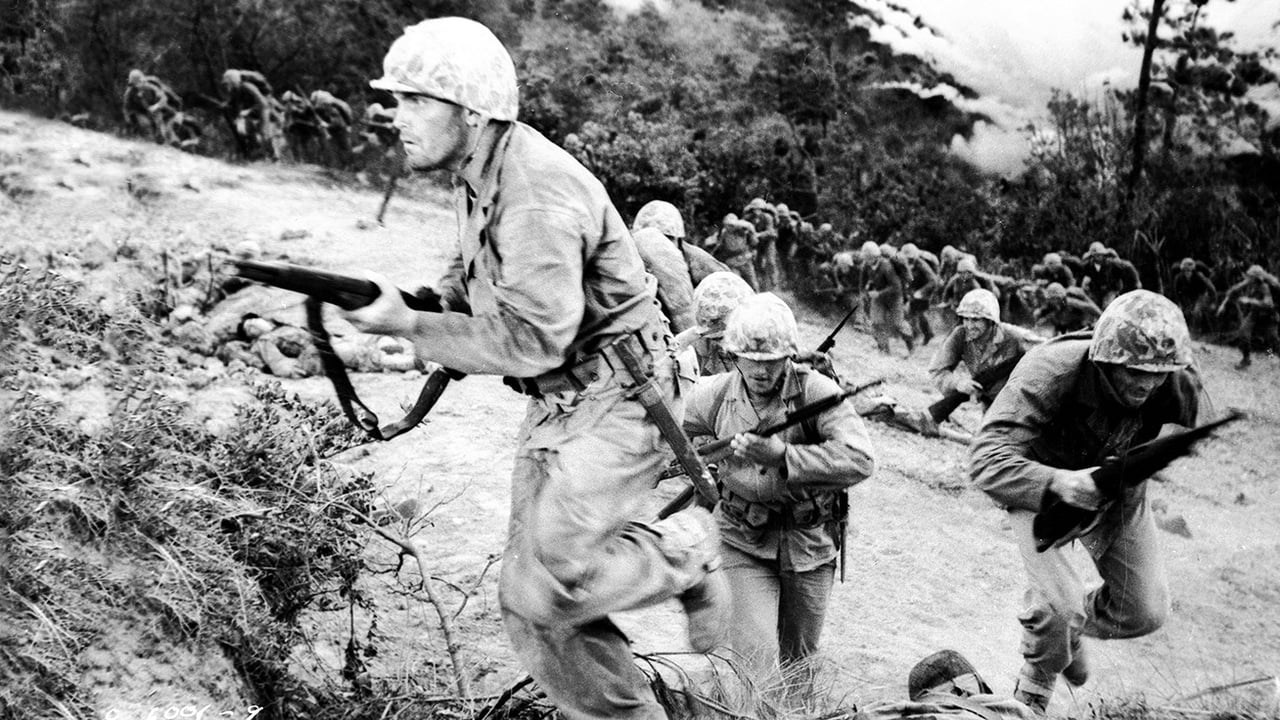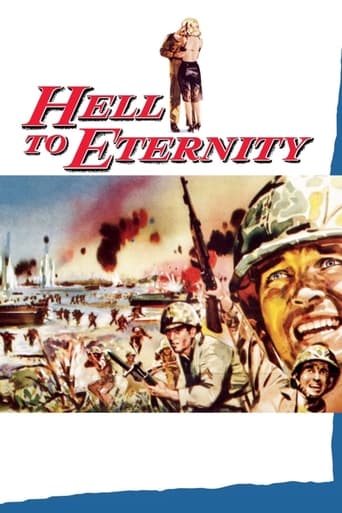Calum Hutton
It's a good bad... and worth a popcorn matinée. While it's easy to lament what could have been...
Taha Avalos
The best films of this genre always show a path and provide a takeaway for being a better person.
Raymond Sierra
The film may be flawed, but its message is not.
Caryl
It is a whirlwind of delight --- attractive actors, stunning couture, spectacular sets and outrageous parties. It's a feast for the eyes. But what really makes this dramedy work is the acting.
Tim Kidner
This rarely shown film was on UK commercial TV channel '5 USA'. Though Hell to Eternity fans out to being a fairly standard WWII war drama, for me it was the opening scenes and background circumstances that make this one stand out above many others.'Yanks vs Japs' movies do tend to be two-a-penny, it seems but lead character Guy Gabaldon (a very good, determined Jefrey Hunter) was brought up from a young age by a Japanese family after his mother dies, in his California community. By the time of Pearl Harbour, and as a young adult, he sees his Japanese siblings as his brothers and of the same blood and race - therefore you can see and appreciate his heartbreak and dilemma on conscription and he is sent out to the Pacific.His knowledge of the Japanese language becomes a huge asset and he becomes a war hero when he uses this talent to get an enemy battalion to surrender and the film is essentially a biopic of him and his story.Fortunately, despite much that could be over-sentimentalised, it never gets too cloying and the dialogue remains pretty much matter of fact, i.e. realistic. It's in quite a flat, grey black & white and it's quite long, but worth sitting through. It doesn't say anything that new and the action won't have you shell-shocked but quite a decent movie, if you can catch it.
MartinHafer
It's rare that I like the idea of a remake. Normally, the original film is MUCH better and remakes almost never stand up to the original movie. However, "Hell to Eternity" has an exceptional story--and with only a few small but obvious changes, it could be a great story...because it's true.This film is about a Marine named Guy Gabaldon. He was a Mexican-American who was orphaned and subsequently taken in by a nice Japanese-American family in the 1930s. When WWII came, his adoptive family was placed in an internment camp and two of his new adoptive brothers went to fight in Europe for the Army. Gabaldon volunteered to fight with the Marines in the Pacific and became an interpreter, since he could speak Japanese fluently. On the island of Saipan, like so many other islands occupied by the Japanese, folks committed suicide in huge numbers to avoid being captured by the Americans--a waste and a serious human tragedy. However, Gabaldon was able to use his skills to save many lives--making him a very unusual hero to say the least! As I said, there were a few problems with the film. First, although the movie was VERY progressive in dealing with anti-Japanese prejudices, the film was also prejudiced in its own way--having the VERY non-Hispanic Jeffery Hunter play the lead. Yes, his acting here was fine--but it also whitewashes the contributions of a minority member--and odd omission to say the least. Second, the middle portion of the film SERIOUSLY loses momentum and the entire stripper portion is very inappropriate. I am NOT anti-sex--but the this actually distracted the viewer and much of this portion is pretty dull. But, with these changes, it is a wonderful story! Well worth seeing.
Brian Camp
HELL TO ETERNITY (1960) is, I believe, the first Hollywood film to depict the experiences of Japanese-Americans in the early stages of World War II. We see a young white guy and his Japanese female companion get harassed by patrons at a drive-in eatery in L.A. on December 7th as news of the sneak attack on Pearl Harbor comes over people's car radios. We see a Japanese-American family listen to the radio together as President Roosevelt addresses the nation and announces a state of war with Japan. We hear a young Japanese-American man describe his unsuccessful effort to enlist in the armed forces. We see Japanese-Americans being forced to leave their homes and possessions and get trucked off to relocation centers. We visit a cabin at the Manzanar internment camp in California. This must have been powerful material in 1960 and, I daresay, remains so today.The movie pulls the viewer in emotionally right from the start as we see a troubled white youth, Guy Gabaldon (who was Mexican-American in real life), get into fights at school and go home to a decrepit shack, only to find his mother gone, taken to a hospital where she will soon die. He is taken in by the family of his Japanese classmate and is reared by them, experiencing genuine familial love for the first time. He even learns Japanese and we see him practicing words. The youth is played by Richard Eyer (the young genie in THE SEVENTH VOYAGE OF SINBAD), a young actor who sure knew how to pull our heart strings. Nine years later in the narrative, in 1941, Guy is played by Jeffrey Hunter and his Japanese brother, George, is played by George Takei. There are scenes between Guy and his Japanese mother that are quite touching, a profound and dramatic illustration of a mother-son bond that transcends language, cultural and racial barriers. (The mother is played by Tsuru Aoki Hayakawa, wife of Sessue Hayakawa, who appears in the film as General Matsui, the Japanese commander on the island of Saipan.) It's the exchange with his mother at Manzanar that convinces Guy to try and enlist in the Marines. (Hunter's portrayal of an orphan raised by a family of different race recalls his role as Martin Pawley, a part-Indian raised by the Edwards family in Texas in John Ford's THE SEARCHERS, 1956.) After such advanced racial politics, there's a bizarre scene about midway through the film showing Guy and two of his marine buddies (David Janssen and Vic Damone) on liberty in Hawaii, where they wind up at the apartment of Sono, a Japanese bar hostess (Michi Kobi) and Famika, her Japanese roommate, a stripper from San Francisco (Reiko Sato). The third woman with them is an uptight white lady reporter, Sheila (Patricia Owens, from THE FLY), who's jealous of the attention paid by the men to the Japanese women and sits there sullenly knocking back one drink after another. Famika does her striptease act in the living room with appropriate music playing on the phonograph and gets the marines very excited indeed. While this action veered dangerously close to yet another case of Asian women being treated as exotic sex objects, the sexual and racial politics take a turn into much trickier territory. When she's finally drunk enough, Sheila, the proper lady reporter nicknamed "the Iron Petticoat," feels sufficiently emboldened to get up and do a striptease herself, much to the amusement of everyone there. Her act is even more revealing than that of the Japanese stripper. Eventually everyone's paired up and, as Guy starts grappling with Sheila's bra strap, there's a quick cut and---BOOM!--the big guns go off in the naval bombardment of Saipan, where the rest of the movie takes place.The scene with the women is a long one and has no bearing on the rest of the narrative. (The women are never seen or referred to again.) I'm not quite sure what the point of it all was, but it's a fascinating footnote in the history of World War II combat movies and certainly pushed the envelope pretty far for 1960. Also, David Janssen's character is crazy drunk in this scene and the actor goes completely wild portraying this state. It's a remarkable display and I guarantee you've never seen him like this in anything he did for TV.After intense and bloody combat on Saipan (filmed on Okinawa), the final stage of the film involves Guy's attempts to get the Japanese holdouts to surrender. Eventually, he confronts the English-speaking General Matsui (Hayakawa), who is planning one last suicidal "banzai" attack by the wounded, weary, and starving remnants of his force and the many Japanese civilians still with them. We hear about the Japanese code of war--no surrender and fight to the last man. And we'd earlier seen Japanese civilians throw themselves off a cliff to avoid capture, having been brainwashed by Japanese propaganda into believing they'd be raped and murdered by the Americans. This represents a much more honest look at Japan's conduct of the war than we were used to seeing in postwar Hollywood films about the war in the Pacific. Contrast this with Japan's own entry in the genre that year, I BOMBED PEARL HARBOR (1960), which I've also reviewed on IMDb. While HELL TO ETERNITY is about 25 minutes too long, it's still a powerful treatment of its subject, despite the unfortunate Hollywood compromise of hiding Gabaldon's true racial background.Jeffrey Hunter and David Janssen would re-team the following year in MAN-TRAP (1961), which opens with a scene of Korean War combat featuring the two and also shows Janssen as a very different kind of character than we normally saw him play. I've also reviewed that one here. Hunter would go on to star in "Star Trek"'s pilot episode, while George Takei would gain fame playing Sulu, a regular character on that show. (As a boy, Takei spent the war years in internment camps.)
vitaleralphlouis
Fifty years ago Hollywood was loaded with patriots, not like today's liberal wimps, and many of them were heroes of World War II. This fine movie is based on a true story about an American raised in the home of Japanese-Americans and his unique opportunity to serve our country in the battle of Saipan, using his language abilities. No spin is needed.What stuck in my mind in 1960 were the scenes when the Democrats (who these days are busy trying to free terrorists from Guantanimo and/or undermining the war on terror) simply disregarded the civil rights of Japanese-Americans and herded them into detention camps. When I saw this in 1960 I had no knowledge of this history, possibly because the ill deeds of FDR and Democrats are habitually swept under the rug.This complex film was brilliantly directed by Phil Karlson, and all parts of it work. The scenes with the hero's adopted Japanese-American family are best, the scenes where the Marines get drunk with three chicks in Honolulu right before shipping out. Great combat scenes, and heartbreak scenes I won't get into.We need films like this on DVD. The net output of patriotic films circa 2004-2008 is absolute zero. Unpatriotic films total about 12, all huge box office failures. Forget about kids learning history in school. And at the Smithsinian Institution's History museum (temporarily closed) kids see a huge display concerning the detention camps, another huge display about Japanese-American heroics fighting in Europe; and exactly 3 square feet devoted to the Japanese attack on Pearl Harbor. Worse is that World War II movies these days (if any) are apt to be made by liberal empty-heads like Jerry Bruckheimer or Steven Spielberg.There is a scene in Hell To Eternity where the camera scans the huge number of dead soldiers on the battlefield but without any stupid comment that war is a waste. Sure it's a waste, if only Japan hadn't bombed Pearl Harbor and decided to start a war to bring about their domination of the Pacific -- if only -- then the fight would not have been necessary.

